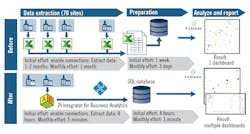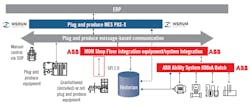Just as any path will get you there if you don't know where you want to go, possessing multiple avenues between plant-floor and enterprise-level systems is only useful if you can take an available shortcut by knowing what data you need and what to do with it.
Until recently, the challenge was just establishing a connection between sensors, I/O, PLCs and DCSs at the operations level and the enterprise resource planning (ERP), manufacturing execution system (MES), IT-based and management solutions on the business side. In the past, this was because so much data translation, protocol conversion, programming and other hurdles had to be crossed. Now, many of those former barriers are gone or diminished thanks to software that automatically bridges former gaps and increasingly plug-and-play industrial Ethernet networking that shoots production data up to the enterprise and its Industrial Internet of Things (IIoT) and cloud-computing services.
"Traditional industries such as oil and gas, petrochemical, pulp and paper, and mining, as well as new economy verticals like renewable energy including solar, wind and energy storage are removing old organizational silos and the lack of visibility that went with them by connecting process, assets and people across the enterprise by utilizing remote monitoring and controls via the Internet and cloud," says Eren Ergin, general manager for the connected enterprise business at Honeywell Connected Plant. "This lets them do regular tasks much faster because clouds like our Experion Elevate let them quickly see all their distributed and remote assets, but also drive more insight from consolidated data without having to maintain the infrastructure and the system themselves."
Melissa Topp, senior director of global marketing at Iconics, adds that, “Many enterprise-level users have either implemented or are considering an IIoT-integrated network. They may be considering IIoT as a way to combine monitoring and control on the plant floor with advanced analytics and other information from enterprise business systems. Today, there are ways to add IIoT networking via comparatively low-cost edge devices called IoT gateways, and some have embedded software that can communicate via multiple industrial, building and energy-based protocols. Iconics' IoTWorX software suite, for example, can integrate with OPC-UA, OPC, Modbus, BACnet and SNMP protocols."
Standardize and democratize
With most network traffic lanes wide open, today's assignment is learning to process and analyze all those newly accessible signals, values, parameters and other data, and use the results to gain efficiencies and improve decisions. Not an easy job either—mainly because freedom usually means more hard work, even if it's your choice.
For instance, global cement and building products manufacturer Cemex in San Pedro, Mexico, operates 70 plants in 21 countries, and recently completed a 20-year effort to achieve informational visibility across all its facilities, add context to data for reporting and analysis, and integrate and analyze operational data at scale to achieve overall enterprise intelligence. "Each of our plants originally had different equipment and practices, so we began standardizing our data infrastructure, defining standards, and standardizing our tag nomenclature," says Rodrigo Quintero, operations model and planning manager at Cemex, who presented "Transforming process data into information" at OSIsoft's 2015 EMEA Users Conference. "However, a regular OSIsoft PI Server had 10,000-15,000 tags for each cement plant, and when you multiply that by 70 sites, it was a lot of data for us to manage. After a couple of years, we had PI infrastructure at all our plants, so we'd achieved global visibility. but then we just stayed at that point for 10-15 years."
During this long lull, Cemex formed an enterprise agreement with OSIsoft, and implemented its Asset Framework (AF) software (Figure 1). "Even though we'd standardized information and restructured it across all the cement plants, we didn’t have the correct context for it," explains Quintero. "So, we began using AF three years ago with this new model, and finally had a standard practice to report all of the information and how it was analyzed, not only for reporting, but for process analysis and everything. That was a big improvement."
Figure 1: To standardize data gathering and analysis, and speed up data extraction at its 70 plants worldwide, Cemex has adopted several OSIsoft solutions, such as PI, Asset Framework and PI Integrator for Business Analytics. Plantwide extractions that used to take 720 hours now take one hour. Source: OSIsoft
The third big step at Cemex was convincing users to get in the habit of using their standardized data on a regular basis, which led them to beta test OSIsoft's PI Integrator for Business Analytics software. "Because we're from the corporate side, we produced a lot of corporate benchmarks and consolidated reports," adds Quintero. "As a result, people asked, 'How does this help?,' 'Can you cross-reference to this?,” and 'How do we compare process, maintenance and quality data?'
Quintero reported that giving out reports and dashboards encouraged Cemex staff to ask more questions, and request more data and analysis, but it didn’t have the capabilities to serve 70 sites or its regional and country offices. "This is where democratization of data comes in," he says. "We wanted people to perform their own analysis with their own global access, so they could start doing their different benchmarks."
Data pain and gain
Quintero added the Cemex had to coordinate several business applications, such as data validation and merging PI System data with its ERP systems because users were spending too much time and effort manipulating data. "It took me two months to extract all of the information from the 70 production sites," he said. "It was a lengthy and painful process, so when OSIsoft offered us the opportunity to participate in the beta testing of its PI Integrator for Business Analytics, we immediately jumped in."
After that, Cemex saw results quickly. "Where the typical data extraction used to take 740 hours, with PI Integrator, it took one hour," added Quintero. "Because it uses the AF structure, it's based on templates, so it's easy to replicate and fast at getting everything. And, since data extraction isn't so complex anymore, users aren't overwhelmed, afraid or discouraged from doing it. In the end, you're shortening this continuous improvement cycle because you have fast information and you can validate it fast, too. You don't have to wait a month or two to get results from reports, which lets our people start conversations. We're tearing down all the barriers across different departments because everybody is looking at the same data, and they're sharing information."
Seeing with HMI/SCADA
While the IIoT and other Internet protocol (IP) options have been getting most of the attention lately, closer ties are also forming between enterprises and regular human-machine interface/supervisory control and data acquisition (HMI SCADA) systems.
For example, SKM Inc., an electrical engineering firm in Bountiful, Utah, near Salt Lake City, recently helped two affiliated, municipal water providers upgrade their HMI/SCADA, in part, so they could share important data more easily, and continue to collaborate on tasks. Mountain Regional Water District (MRW) and the City of Park City, Utah wanted to improve their HMI/SCADA systems, and sought a more reliable and robust HMI that could affordably provide good data visibility, alarming and expandability.
As research progressed, MRW and ParkCity learned they needed to share data and run automated reports, according to Allen Rogers, electrical engineer at SKM, who reported the two water utilities eventually adopted Ignition SCADA software from Inductive Automation. "MRW was the first to do an upgrade, and decided to use Ignition's features after becoming tired of its existing software's licensing model and lack of feature improvements," says Rogers. "SKM streamlined the projects by using templates and custom user-defined types (UDT) to bring more data to the front. MRW’s original project had 5,000 tags and the new project has 65,000."
In addition, MRW began using Ignition to monitor and optimize energy consumption, track efficiencies, and find water leaks before they became large or were called in. The project was able to pay for itself in a few years thanks to savings created by the new levels of data and the added control. During completion of the MRW project, ParkCity sought to upgrade its SCADA system, too. One of its long-term goals was integrate its HMI/SCADA system with its maintenance management software and automatic metering systems. With Ignition in place, ParkCity gained a much larger view into its system. The city went from 10,000 tags to 135,000.
MRW and ParkCity share ownership in some large assets and water sources, including a large pump station operated by MRW. The site also has a water quality station operated and maintained by ParkCity. Each organization wanted to see the other’s data because it was fairly critical to both operations. Ignition was used to solve this problem, too. Using the Web Dev Module, each organization serves up a JSON with pertinent data that is read in by the other organization’s servers.
"The biggest result was two satisfied customers and several benefits," adds Rogers. "Both have future plans, including integration into other systems and adding more physical I/O. One big benefit is neither MRW or Park City will have to go back to Inductive Automation and pay more money to work on future projects. And SKM is seeing more users at both organizations getting engaged with Ignition and creating their own screens with help from SKM and InductiveUniversity."
Assuming responsibilities
When old, organizational levels are breached, new tools are needed to handle the surprising volume of newly released data. Naturally, many users are looking to software, cloud-computing services and the Industrial Internet of Things (IIoT) to give them a hand.
For instance, DSM Nutritional Products' vitamins and carotenoids plant in Village-Neuf, Alsace, France, uses about 200 raw ingredients in more than 1,000 recipes, including vitamin premixes, which need to ship within four weeks after orders are received to secure required analysis certificates. This requires reliable planning and traceability at each production step, so until 2013, the premix plant used tailor-made process controls that required strictly sequential process steps.
To improve efficiency and prepare for future demands, DSM recently sought a new MES to serve between its business-level ERP and plant-level SCADA, and implemented ABB's cpmPLus enterprise connectivity system (ECS), which is based on virtualized servers and provides standardized interfaces to DSM's ERP system in accordance with the ISA95 standard, and supported by SAP for vertical integration of process automation. ABB supplied seven workstations for its 800xA control system in conjunction with cpmPlus ECS, as well as 15 other stations just for cpmPlus ECS.
DSM engineers used the arrival of the new MES to reassess and optimize its processes, and developed an implementation that might appear over-engineered with respect the present requirements, but is more prepared for future needs. "This approach facilitates our adaptation to the future tightening of of requirements in process safety and traceability," says Gilles Nodot, product manager at DSM's premix plant. The new MES also allows DSM to perform some production steps in parallel, rather than in strict sequence. For example, in the past, all raw materials required for a production lot had to be available onsite at the same time for production to begin. Now, weighing and portioning can begin as soon as the first components are unpacked. This increases the flexibility of ABB’s MES system at the weighing stations, and alleviates a bottleneck.
“With the new MES, we have real-time information about the entire process, and it's more reliable and transparent,” explains Nodot. “We know at any time how much of what material is at which process step. This permits a detailed planning process with much reduced demands for storage of raw materials. It's difficult to quantify the efficiency gain from the MES, since we optimized the processes at the same time," adds Nodot. "However, we believe it's a double-digits percentage."
Mariam Coladonato, lead product marketing specialist for networking and security at Phoenix Contact, adds that, "More network integration is happening at the industrial level thanks to Ethernet standards that allow easier use of IT-based concepts like IIoT. However, even though many users and businesses want to use new digitalized tools, there are still internal issues that often get in the way. Who owns this integrated network? Who's going to manage and maintain it? Is IT or operations technology (OT) going to support an IIoT environment?"
Coladonato reports that sometimes an IT department will take over these tasks, which may not be helpful to plant and operating functions if they're not specifically addressed. More recently, she adds that younger OT engineers have been performing IT jobs on the OT side because they're more familiar with those technologies. "Just as we integrate industrial networks, we also need to integrate these human groups that use them," says Coladonato. "This requires talking by everyone on all sides with each other, which means it must be pushed by some type of vice president or other high-level executive that can make it happen and get the rest to follow. Unfortunately, many of these decisions aren't being made, and integration projects aren't succeeding even with internal champions because they don't have enough power or support."
Honeywell's Ergin adds that, "One of our clients in Canada just acquired 500 wells, and had to add them to its system quickly with a minimum of capital expenditures (CapEx) and operational expenditures (OpEx). They were using Honeywell ControlEdge remote terminal units (RTU), which gave them the capability to store data for reliability of operations, but they pushed most of it to the cloud via Experion Elevate, which provided critical process data such as pressure, temperature, flow, etc.
"This also let the enterprise users see the well data, and ask operators to make some control setting changes remotely. The operators can see the same information on their smart phones and apps, tell what gas valve operating parameters they're using, for example, and fix issues while they're on the phone in the field without going back to their desks. This allows our customers to focus on assets that actually need attention and minimize OpEx and increase revenue with a direct impact to their bottom line. Intelligent wearables, which can be connected to our Experion Elevate and enterprise solutions, also enable the field teams to connect to headquarters for more support, and give young operators more assistance."
Securing the plant-enterprise path
Human reluctance aside, Coladonato adds some plant-enterprise integration efforts are aided by software that can identify devices and their firmware, show ranking levels depending on their vulnerabilities, show traffic flows in firewalls, and automate other tasks. These include using IIoT for asset discovery, patching and updating, cybersecurity and vulnerability management, and firewall assurance and change management. She adds that properly installed and configured software from Splunk, Security Matters and Skybox Security can assist these efforts.
"One big IIoT idea now is doing security during asset discovery," adds Coladonato. "For instance, if you have 100 devices including 10 PLCs, and you're scheduled to do an automatic patch update or firmware download from the supplier, then you can also get vulnerability assessment and management software involved to update the same PLCs and firewalls. The big problem with IIoT is there are many different solutions, and while some are easy, others have a big learning curve or are so specific that they only address one or two functions in a particular application or industry. No one tool does it all, so you have to assess what your application needs."
Iconics' Topp adds, "Enterprise users who haven't yet made the move to IIoT due to security concerns may be assured by the latest advances in secure cloud communications. First, the major cloud-based service providers, such as Microsoft Azure, are continuously strengthening their server-side security. Second, the developers of the applications that access these cloud-based services have also implemented the latest communications protocols. For instance, Iconics IoTWorX is compatible with: AMQP for bidirectional communication between IoTWorX and cloud services like Azure, MQTT for outbound communication between IoTWorX and third-party apps, REST communication to web services, and JSON user-configurable messaging."
Figure 2: Werum IT Solutions integrated its PAS-X MES with 800xA Batch Management from ABB, and its plug-and-produce tool lets users perform digital-twin modeling to test how a production line runs in the digital/virtual world before deploying in the real/physical world. They also developed message-based communication to send and receive instructions between the MES adn equipment and provide synchronization between systems. Source: ABB
Get the digitalized message
To further simplify and shrink the plant-floor/enterprise gap, GE Healthcare's greenfield pharmaceutical facility in Uppsala, Sweden, has adopted the Shop Floor Integration for Life Sciences add-on to Ability Manufacturing Operations Management (MOM) software from ABB that relies on its Ability 800xA distributed control system (DCS). The Uppsala plant is reported to be one of the world's largest installations for producing chromatographic resins, and it uses ABB's message-based plug-and-produce approach to integrate its automation and equipment levels for making a chromatography medium. It's estimated that Shop Floor Integration saves 40-70% of the time engineers usually devote to integrating comparable systems.
Similarly, Werum IT Solutions recently integrated its PAS-X MES with 800xA Batch Management to simplify operation for users, create master batch records (MBR) faster, and allow joint deployment and validation (Figure 2). This new plug-and-produce tool lets pharmaceutical manufacturers perform digital-twin modeling by installing its interface onto existing equipment, which lets engineers test how a line runs in the digital/virtual world before any connection are made in the real/physical world.
In addition, ABB and Werum have developed and deployed a message-based communications system to send and receive instructions between the MES and production equipment, and it provides regular synchronization between the systems and communicates data such as quality, setpoints and consumption. They report that bringing together their offerings lets them deliver full-scope engineering and validation in accordance with GAMP 5 guidelines and comply with regulations such as U.S. Food and Drug Administration's (FDA) 21 CFR part 11.
About the Author

Leaders relevant to this article:




